An old Dutch proverb states: Having good tools is like having half work done. It’s true – no workman can do a good job without the proper tools. Fishing is no different. If you want to be a proficient angler, you need adequate angling equipment.
A fishing rod is the foundation of any angling setup. Quality is the key, but it does not necessarily mean you have to spend a fortune. As long as you choose the right type of rod that matches your body type, fishing style, and water conditions, you are equipped for success.
But how to choose the best fishing rod?
The choice of fishing rods is often overwhelming. To avoid confusion, stay and learn all you need to know about different fishing rod types and where and how to use them.
Fishing Rod Components
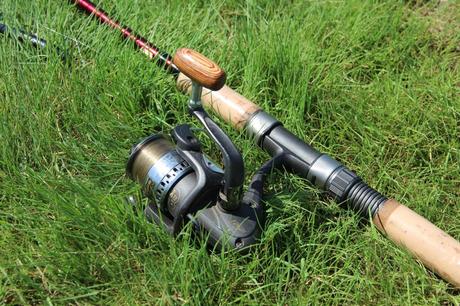
In order to choose the best type of fishing rod for your future fishing adventures, you need to learn about the universal components all fishing rods share. These parts are more or less the same. Slight differences serve to distinguish different fishing rod styles.
I’ll start from the bottom up!
The Handle
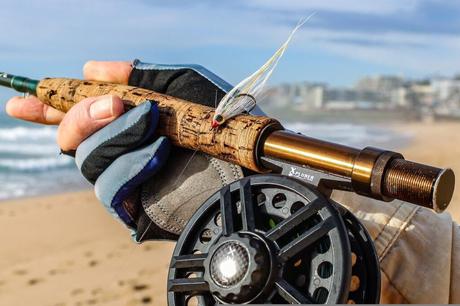
A handle is at the very bottom of every fishing rod. It serves to hold the pole and should thus ensure a comfortable, secure grip. For this reason, handles are typically made from durable, non-slippery, and comfy materials, such as EVA foam or cork.
Handles vary in length. Longer handles are best suited for longer casts. They enable the angler to use both hands and handle more load. Shorter handles, on the other hand, are made for anglers who prefer shorter casts. Hence, if you favor one-hand casting, choose a rod with a shorter handle.
Fishing rod handles come in an array of different shapes. Some are more popular than others, though.
Pistol grip handles are short and contoured. They have a convenient hook for your index finger. These handles make casting easier and more accurate but are hard on the wrists and allow big fish to overpower the rod.
Trigger stick handles are longer and enable you to cast with both hands. Hence, you can cast much further. You should opt for a trigger stick handle when targeting large and heavy fish.
Popular split grip handles make fishing rods lighter and distribute the weight at two points securing more balance for one-arm fishing.
The Reel Seat
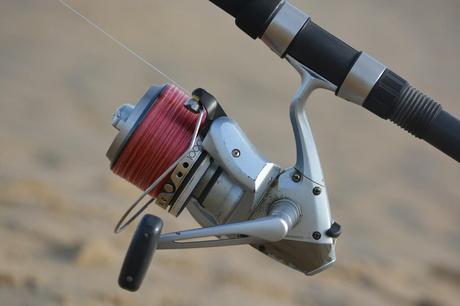
The reel seat is situated right above the handle. It is a part of a fishing rod that serves to mount the reel. Reel seats come in many styles and sizes, but they all share one purpose – to secure the reel to the rod and make the setup solid.
A saltwater casting reel seat is similar to a freshwater casting seat as far as the body style is concerned. Both have the same components, such as the trigger and the locking hood.
So what’s the difference?
A saltwater seat is typically larger (size 18 to 24) than a freshwater seat (size 16 or 17) because it has to accommodate a larger reel suitable for grappling big pelagic fish species. To determine the size of your reel seat, you have to factor in three things:
- The size of the reel
- The inside diameter (I.D.) of the reel seat
- The outside diameter (O.D.) of the rod blank
Extra Tip: Measure the diameters with Digital Calipers!
As far as a reel seat arbor is concerned, you do not need my help. All the arbors are almost equally strong and durable. Hence, the choice comes down to your personal preference.
Installing a reel seat the right way is imperative. If you are not sure how to do it, watch the video below:
Blank And Guides

The blank is the main shaft portion of a fishing rod. It is typically made from graphite, but there are other possible materials. If you decide to build a fishing rod on your own, you can purchase a rod blank from a number of suppliers. Things you need to consider are:
- Weight & length of the blank
- Number of sections
- Action
Guides are placed on the blank and serve for threading the fishing line. They can be made from plastic or metal. The last guide in a row is always the thinnest – it is the so-called tip.
The position of the guides depends on the type of rod:
- Casting rods have guides on the top facing the sky
- Spinning rods have guides on the bottom facing the ground
How should you determine the size of the guides?
To decide which size rod guides you need, you must measure the inside diameter (ID) of the ring. In this way, you will determine the size of the smallest guide on the rod.
Most conventional rods call for standard guide sizes (6, 8, and 10mm). Heavy-duty saltwater fishing rods require guides as big as 16mm.
In general, the more guides you have on a fishing rod, the greater the sensitivity and power of the rod. Smaller guides reduce line slap, distribute stress more evenly, and allow for longer casts.
Guides have ‘feet’ or extensions that you need to lie against the blank and secure with either nylon or silk thread. Once you are done, you should use a slow-cure epoxy to coat them.
Extra Tip:
Keep turning the rod during the curing process to ensure epoxy cures evenly and does not form bulges or sags.
The Ferrule
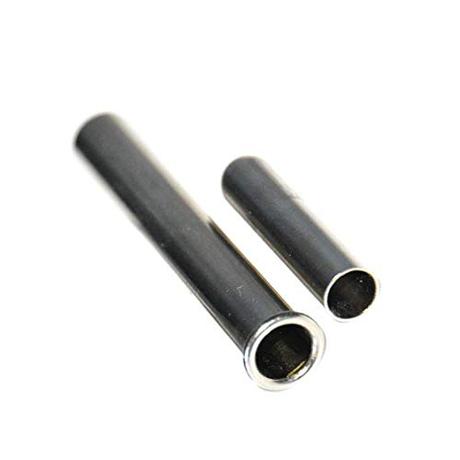
A ferrule is a hollow metal tube that joins two pieces of a fishing rod blank. It can also be used to repair a broken rod. Ferrules are typical for fly rods and travel rods. Collapsible fishing rods have two ferrules:
- A male ferrule
- A female ferrule
When you are ready to use your rod, you must connect these two pieces making sure that the guides line up properly. If you are not sure how to do it, check out the following video:
What Are The Different Types Of Fishing Rods?

There are two main ways to differentiate fishing rods. First, and foremost, rods are distinguished by their purpose, i.e. the type of fishing they are for. There are seven types of fishing rods suitable for particular types of fishing.
Fishing rods are also characterized by the material they are made of. In this regard, you have several options to choose from depending on your level of expertise and angling mode.
Let’s discuss this in more detail!
Types Of Fishing Rods According To Fishing Style
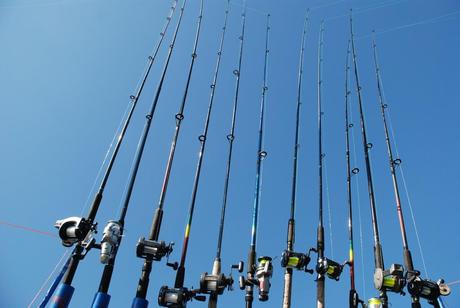
The seven types of fishing rods that are distinguished by their purpose are:
- Spinning rods
- Fly fishing rods
- Casting rods
- Surf rods
- Boat rods
- Trolling rods
- Ice fishing rods
- Telescopic rods
- Ultra-light rods
Some rods are more versatile than others, yet, every rod is best used for the type of fishing it has been designed for. Let’s now learn more about each type of rod on the market.
Spinning Rods
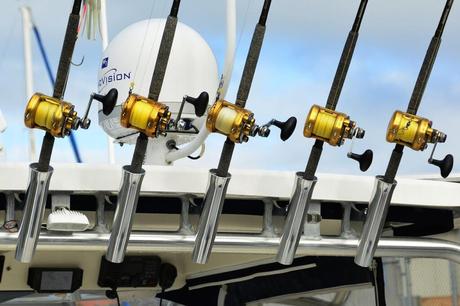
Spinning rods are highly popular, versatile, and suitable for beginners. If you want a general-purpose fishing rod, buy yourself a spinning rod too.
A spinning rod calls for a spinner bait (spinner rig). It is typically used for trolling, still fishing, deep water fishing from boats or docks, float-and-fly bass tactics, and live-bait fishing for panfish, catfish, and walleye. It is not suitable for targeting fish in heavy cover.
Spinning rods have all the components I’ve listed in the previous section: a handle made from foam or cork, a body made of fiberglass or carbon fiber, and large, heavily tapered metal guides facing downward. However, they are most distinguished by a spinning reel and a flexible tip.
A spinning reel is a fishing reel that consists of a nonmoving spool and a revolving arm. It sits on the underside of the handle, at the bottom of the rod. You spin it with your non-dominant hand while holding the rod with your dominant hand. This allows for total control and accurate, long casts.
When you cast the line, the tip of the fly rod bends downward. It enables you to cast farther than with other types of fishing rods. Unlike rods with heavy power, a spinning rod is suitable for both calm and windy conditions.
Spinning rods come in a variety of sizes and actions. The shortest, ultra-light rods are reserved for ice fishing.
The short, light-action spin rods are ideal for panfish or trout fishing. 6 to 7-foot, medium to medium-heavy action rods are perfect for bass fishing. Longer, heavy action rods with grip handles serve for targeting large fish, such as steelhead, salmon, or marine fish.
Recommended:
Ugly Stik Elite Spinning Fishing Rod
Best Used For:
- First-time fishing
- Trolling and still fishing
Pros:
- Easy to master – no practice needed
- Ideal for most fishing scenarios
- Not prone to fishing line tangles
Cons:
- Should not use it in murky water with heavy vegetation
- Insufficient torque and strength to battle a fish heavier than 10 pounds
If you are a beginner looking to learn how to cast a spinning rod, check out the following video:
Fly Fishing Rods
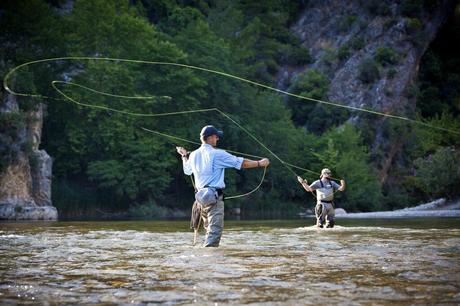
A fly rod is a fishing rod designed for fly-fishing. At the first glance, fly rods are not much different than any other – they have a tapered tube made of carbon fiber, guides, a reel seat, and a handle. However, it is where similarities end.
In comparison to most other types of rods, fly rods are much lighter and thinner. The guides are typically significantly smaller and mounted closer to the blank. The reel seat is located at the bottom of the rod (underneath the handle) to provide balance when casting.
Even though the reel is there, you are not supposed to use it to pull in the line while fly fishing. Fly-anglers usually pull the line off the reel before they begin to fish and wind it back on when they are done. That is why fly rods must be paired with fly reels only. Spinning reels and baitcasting reels are of no use for fly fishing.
The fly line is much thicker than the ordinary fishing line. It is weighted, too. There are several options for you to choose from depending on how you plan to use it, such as sinking, floating, or sink tip type of line.
Fly rods share the same classification as spinning rods. Hence, they are differentiated by their length and casting weight. However, since flies used to fly fish are very light, the weight of fly rods cast is that of the line and not the lure.
Hence, in this case, rod classes are actually line classes. These so-called AFFTA classes range from 0 (which is extremely lightweight and exceptionally rare) to 15 (which is super heavy and equally rare).
The lower the line class, the lighter the line is, and the smaller the fly you can cast and the fish you can catch. If you aim to target a larger fish in larger water (steelhead, salmon, or tarpon), you should go for at least class 10. Most often, anglers keep within the 4 – 9 line class range. Some rods can be used for several line classes, too.
Do not be confused if you see a casting weight expressed in ounces or grams. Some manufacturers label the recommended casting weight on their rods in such a way.
As far as the length of the rod is concerned, fly rods are typically much longer than spinning or baitcasting rods. The most popular and sought length among fly-anglers is 9 feet. The maximum length you can purchase is 14 feet.
As you can see, fly rods come in quite a few sizes and lengths, which makes them suitable for targeting almost every fish you can imagine. It is one of the greatest advantages of this type of fishing rod.
Recommended:
Redington Fly Fishing Classic Trout Rod
Best Used For:
- Trout, salmon, and steelhead fishing
- Targeting fly-fishing-only waters
Pros:
- You can use it in any body of water, including the ocean and fly-fishing-only waters
- You can target almost any kind of fish
Cons:
- You’ll need to invest a lot of time and practice to learn how to use a fly rod
- Casting requires a lot of space
- Wind can influence your performance
Casting Rods
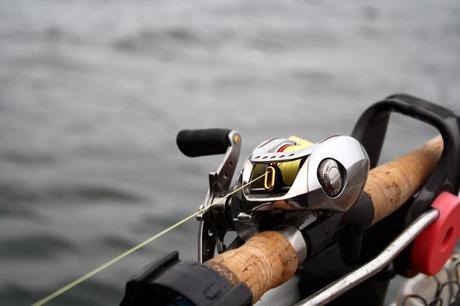
A casting rod is often used for the same type of fishing as a spinning rod, which makes choosing the right fishing rod quite challenging at times. The one difference you can spot right away is the position of the reel.
While the spinning reel sits underneath the handle, the casting (baitcast) reel sits on top of the handle, facing the angler. The same goes for guides – they face downwards on a spinning rod and upwards on casting rods.
A spinning reel features a fixed spool, and the line is wound by hand. The casting rod features a revolving spool that turns as you cast. As a result, a casting rod can cast much farther and more accurately which makes it a better choice for targeting a specific area on the water.
Since the spool turns automatically, a casting rod has a braking mechanism, too. It can be centrifugal, magnetic, or combined.
There are two sorts of casting rods:
- Baitcasting rods
- Spincast rods
The two are pretty similar, yet, once again, the main difference is in the reel. Namely, spincast reels are much easier to use than baitcasting reels. They are also more affordable. Since there is no risk of backlash, spincast reels are safe for children, too.
These reels have a button to switch between locked and free-spool. They also have a drag adjustment mechanism that regulates the amount of resistance a fish on the line feels.
On the downside, the casing that houses the mechanism can cause quite messy tangles and hold water and debris that can damage the reel. Luckily, spincast reels are so inexpensive that it does not matter much if they last only for a season or two.
A baitcasting reel is more advanced and calls for a more experienced angler. It is prone to backlashes since the spool tends to move faster than the casting line and cause a knotty mess. With practice, everyone can overcome this problem.
Since your dominant hand holds the baitcasting rod and controls the reel, you must learn to use your thumb to break the line and prevent backlash.
The advantage of the baitcast reel is its versatility. You can use it with multiple types of bait, lures, and lines. It is an ideal choice for dropping your line in a crowded spot, but it is also powerful enough for offshore fishing. It is the most popular type of reel for bass fishing.
Recommended:
Dobyns Rods Fury Series Casting Fishing Rod
Best Used For:
- Fishing with kids (especially spin cast rods)
- Bass fishing
Pros:
- Suitable for both offshore and inshore fishing
- Superior casting control and accuracy
Cons:
- If you use a casting rod with a baitcast reel, you are likely to deal with nerve-racking tangles.
A spinning rod or a casting rod? Which one is better? The following video might help you resolve that dilemma:
Surf Rods
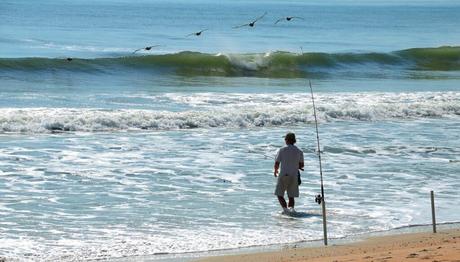
Surf rods, or sea rods, are designed for sea fishing or surf fishing (of course). You can use them to fish from shore or boats and larger ships if you prefer fishing out at sea.
Surf rods come as either casting rods or spinning rods. They are typically very long and made from durable materials resistant to corrosion. As a result, they can withstand the harsh conditions out on the sea or the ocean and cast at incredible distances well beyond the waves breaking near the shore.
Unfortunately, the extra rod length and durable but come at an extra cost. Hence, the best surf rods are fairly expensive and might not be a valid option for an occasional angler.
The good news is that you can always find the right size rod no matter what marine fish species you target since surf rods come in a variety of sizes and thicknesses.
If you are a beginner, I recommend a surf rod between 8 feet and 10 feet long, equipped with a 6000 to 8000 series spinning type of reel that can hold at least 500yds of 25lb braid. You should always use a braided fishing line for sea fishing (25lb to 50lb) so that you can cast heavy baits.
As far as power and action are concerned, surf rods should be medium-heavy with moderate action.
Recommended:
Penn Prevail & Prevail II Surf Casting Fishing Rod
Best Used For:
- Fishing from a beach, pier, dock, or a boat out on the sea
- Shallow sea fishing
Pros:
- Considerable casting distance
- Suitable for fighting huge fish
Cons:
- Rod’s weight, length, and price might be too much to handle for some anglers
- Limited use
Boat Rods
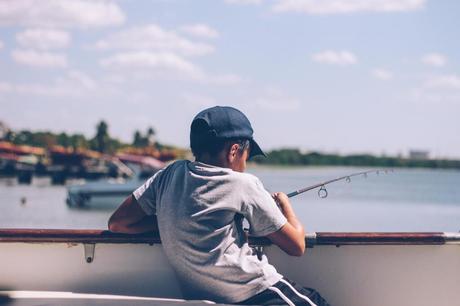
Boat rods are designed for deep-water fishing and are thus most often used for deep-sea fishing. They are typically short since there is no need for casting. All you need to do is lower the lure over the side of your boat, and you are good to go.
On the other hand, boat rods must be heavy-duty and made from durable materials such as solid fiberglass. They are not made for smaller fish; quite the opposite, they must be able to withstand battling large marine species and have enough power to pull out your catch from a great depth.
Therefore, a reel on a boat rod must be able to hold a heavy line – and plenty of it. When doing deep-sea fishing, the bottom of the mark can be as much as 200 meters deep. Once you count in the pull of the tide, you need at least 10% more line on your spool.
Most deep-sea anglers opt for a multiplier reel. It is an excellent choice for boat fishing as it can hold enough line and provide sufficient power. It does take some time to master, though.
Recommended:
Daiwa Proteus Winn Boat Conventional Rod
Best Used For:
- Deep-sea fishing
Pros:
- Stout, shorter rod with enough power to pull out a deep water monster
Cons:
- Not suitable for casting.
Trolling Rods

Trolling rods are heavy-duty, stiff rods (usually in the 6 ½ to 7 ½ foot range) that are meant to be used on boats. However, unlike the boat rods we have covered in the previous section, these fishing rods are not meant to be held by an angler. They are mounted in a holder, usually at the back of a boat.
The boat should move slowly so the lure can “swim” and attract fish. The trolling technique is generally reserved for large, heavy fish such as marlin or tuna. Yet, it is often used for bass and crappie fishing too.
It does not matter what species you target – if you are an open-water troller, you must consider depth, type of lure, line diameter, and amount of line on your spool. It would be wise to get a line counter reel as it replicates trolling patterns and eliminates the guesswork. A two-speed reel is an excellent choice as well.
Other desirable features include a level wind and a clicker. If you are all alone trolling out on the water, a clicker is a necessity. It delivers a loud audible signal you can hear over the engine noise and pull out your catch on time.
A modern fishing rod for offshore trolling comes with add-ons called “guides” that reduce line friction when the rod is bending. There are two different designs:
- Roller guides (for larger fish species)
- Turbo guides (lighter & easier to handle)
Trolling rods are not for everyone. However, if you do a lot of lake or sea fishing with your boat, this is the right rod type for you.
Recommended:
Okuma Classic Pro GLT & Rods
Best Used For:
- Offshore fishing in lakes or the sea
Pros:
- When using a trolling rod, you can cover a lot of water in a short time and catch fish at depths where most casting rods do not work
- Highly precise depth and speed control
Cons:
- Trolling is not suitable for anglers that enjoy hooking and unhooking the fish themself
Ice Fishing Rods
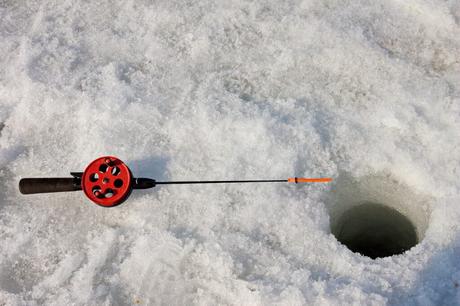
As their name clearly implies, ice fishing rods are designed especially for ice fishing. They resemble spinning rods but are much shorter (usually just two to three feet long).
Being so short, they cannot be used for casting – all they are good for is lowering a lure directly into an ice hole. On the bright side, this makes these rods super easy to operate and an excellent option for fishing with kids.
Ice rods should best go with an inline reel that has been designed especially for the purpose. If you do not want to invest in a new reel, you can pair up an ice fishing rod with a spinning type of reel.
Ice rods are suitable only for small to medium fish – not bigger than a walleye or pike. If you try to catch a bigger fish, your rod might crack. Luckily, these rods are not expensive.
Recommended:
Shakespeare Ugly Stik GX2 Ice Fishing Reel & Rod Combo
Best Used For:
- Ice fishing
Pros:
- Easy to use
- Suitable for kids
Cons:
- Not appropriate for larger fish species
Telescopic Rods
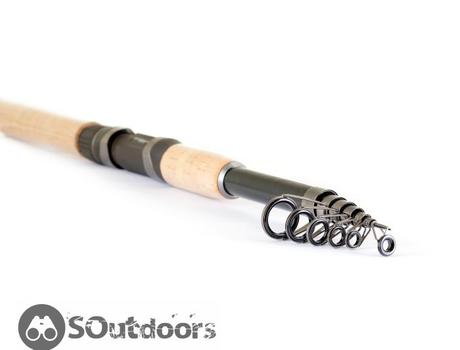
A telescopic rod is a fishing pole that can open up or extend. It is an excellent choice for anglers who are constantly on the go or do not have a lot of space in their car. Being so compact, it is easy to pack and carry wherever you go.
Typically, closed telescopic rods are only one to two feet long. However, you can extend them to as much as 20 feet! The assembling process is quick and easy. Casting, on the other hand, requires a bit of practice.
An extended rod is very long and flexible – that is why these rods come without eyes. You can find a telescopic rod in a baitcasting or spinning form. A flexible tip makes them ideal for surf fishing, too.
Recommended:
KastKing Blackhawk II Telescopic Fishing Rods
Best Used For:
- Anglers on the go
- Surf fishing
Pros:
- Compact and portable
- Transforms into a more extended rod
Cons:
- Tend to wear down more quickly than other types of fishing rods
Ultra-Light Rods
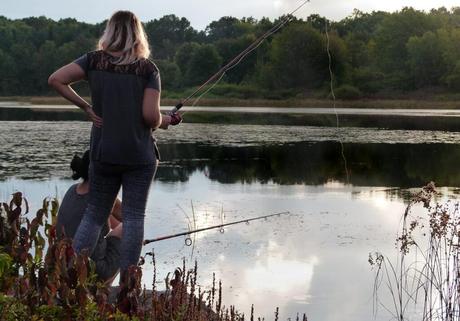
An ultra-light rod makes fishing a thrilling adventure. Unlike heavier alternatives, these rods boast ultimate sensitivity and can detect even the lightest strike. They are ideal for fishing in creeks and shallow ponds.
An ultra-light rod is typically made from graphite or carbon fiber and has a light line. It is on the shorter side but must be long enough to cast a tiny, light jig some distance. The best bait is wet flies, little spinners, and plastic worms.
Even though delicate, ultra-light rods are by no means weak, they might bend like marsh grass in the wind. Yet, when handled properly, they can catch quite an impressive fish. Most often ultra-lights are used for targeting small fish such as panfish and trout but can score a bass too.
Ultra-light rods are typically equipped with spinning reels. This type of reel offers less friction and handles light lines much better than a baitcasting or closed-face reel.
Recommended:
St. Croix Rods Premier Spinning Rod
Best Used For:
- Catching smaller fish species in shallow water
Pros:
- Supreme sensitivity
- Allows you to target cautious fish with tiny lures and jigs
Cons:
- Not suitable for big lures, big fish, or big waters
- Tend to be more expensive than other types of rods
Types Of Fishing Rods According To Material
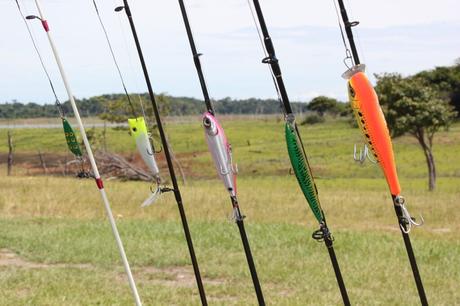
As we have already established, fishing poles can be made from different materials. The material you choose can have a significant impact on your rod’s activity and your performance. Let’s see what your options are.
Fiberglass Rods

Fiberglass rods are budget-friendly but somewhat heavier than those made from graphite. If you buy a modern high-quality fiberglass rod, this difference might be as little as 0.1 ounces.
On the other side, a fiberglass fishing pole is more durable and has more power too. Hence, it is best suited for targeting heavy fish. The most durable and strong sea trolling rods are made from solid fiberglass and are virtually impossible to break.
Fiberglass rods boast excellent flexibility and responsiveness and are usually slow to medium action rods. They are not the best option for distance casting.
If you are a beginner, a fiberglass rod might be the right fishing rod for you. It does not require any complicated maintenance and is quite easy to handle.
Recommended:
Moonshine Rod Co. The Revival Series Fly Fishing Rod
Graphite Rods
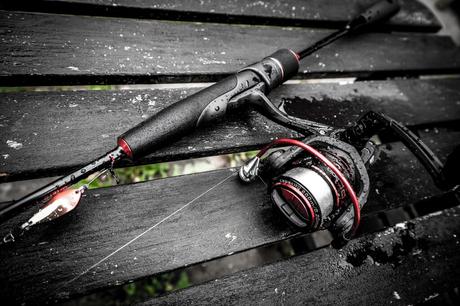
Graphite rods are light and deliver more finesse than some other types of fishing rods. They are typically fast-action rods. Unlike fiberglass rods, they flex more at the top.
Rods made from graphite often bear a hefty price tag, though. It is probably due to their popularity among pro anglers. They are valued for their exceptional fighting power and sensitivity. If you seek accurate casting, this might be the right fishing rod type for you, too.
On the downside, graphite poles can be more brittle. As a result, a large fish can strain a graphite fishing rod to a breaking point.
Recommended:
KastKing Perigee II Fishing Rods
Composite Rods
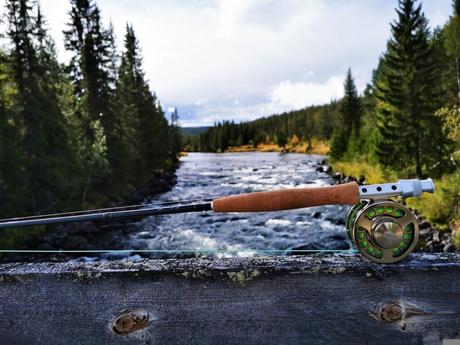
If you want the best of both worlds, you should opt for a composite rod. These rods combine fiberglass and graphite material and can be used in different fishing environments. They have a mid-range price as well.
Recommended:
Fiblink 1-Piece/2-Piece Saltwater Offshore Heavy Trolling Rod
Bamboo Rods
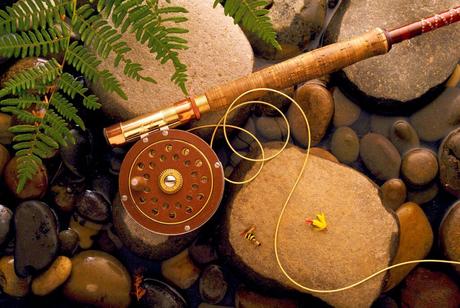
Bamboo rods are the heaviest and least versatile. On the other hand, they provide the most subtle and delicate presentation. If you enjoy a slow-action, flexible rod – go for bamboo, you won’t regret it! The organic feel and smooth casting are worth the high price.
Recommended:
Winston Bamboo Fly Rod
If you would like to learn how to cast a bamboo rod, check out this video:
Extra Tip:
You should consider your level of expertise and preferred fishing method when considering the rod material.
What To Consider When Buying A Fishing Rod?
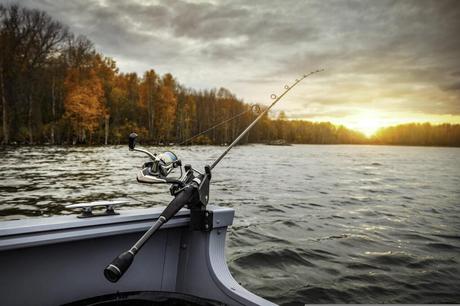
Now that you know all the basic fishing rod parts and have a full understanding of the different types of fishing poles, it’s time to discuss the things you should consider when buying your next fishing rod.
Rod Length

You should begin measuring your rod length from the end of your handle and continue all the way to the very tip. Why is length important?
The length of your rod has a significant impact on your casting ability and fishing success. Shorter fishing rods cast shorter distances, and vice versa. It does not mean that longer rods are better – each rod has its purpose.
If you want to drop a lure off a boat, or directly into an ice hole, you should use a short rod. Shorter fishing rods also bend less and are thus better for fighting aggressive fish. Longer fishing rods can cover more water. They are suitable for deep fishing too.
Fishing rod length ranges from six to 12 feet. When choosing a rod length you should consider the fishing environment, type of fishing, and the fish species you want to target. Beginners should stick to 7-foot rods, as they balance the casting distance and accuracy well. 8-foot and 9-foot rods are considered all-purpose rods due to their versatility.
Rod Weight

Rod weight is usually marked right above its handle. So, what does a 5lb marking mean?
Contrary to common opinion, these markings have nothing to do with how much weight your rod can lift or the size of the fish you can catch using it. The rod weight you can read on your rod blank shows the line weight it is designed for. Hence, a 5lb rod is designed for a 5lb fishing line.
The same markings can be found on fishing reels. Therefore, you should always get a fishing reel designed to handle the same line strength and lure size as your rod.
Rod Action
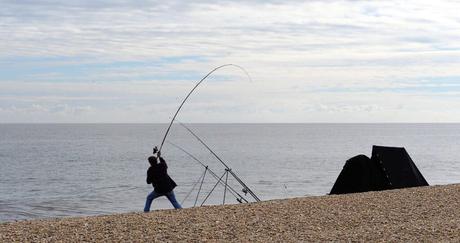
Rod action denotes its flexibility. It shows how much a rod can flex when bent without breaking. A fishing rod can be categorized as:
- Extra fast
- Fast
- Moderate fast
- Moderate
- Moderate slow
- Slow
- Extra slow
The rods that bend all the way from the bottom are slow-action rods. The ones that bend only at their tip are fast-action rods. Medium action rods bend halfway their length and are the most versatile option.
Fast action rods are the best option for throwing lures as they provide better casting distance and accuracy. Fishing rods used for sea fishing (boat and trolling rods) are either medium or slow action rods as they are more flexible and best suited for fighting large saltwater fish.
Rod Power
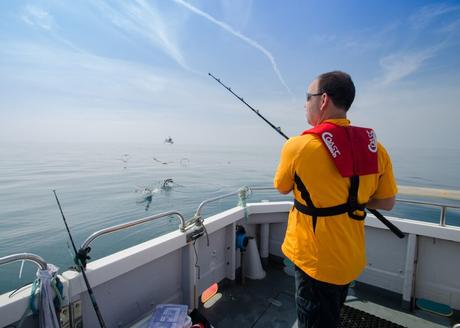
Rod power and row action are often confused. It is no wonder since both terms refer to the rod’s bending behavior. However, rod action shows us where the bending happens, and rod action tells us how much force it takes to bend a rod. In short, rod power denotes how resistant rods are to bending.
There are seven possible categories:
- Ultra-light
- Light
- Medium-light
- Medium
- Medium-heavy
- Heavy
- Ultra-heavy
If a fishing rod is categorized as ultra-heavy or heavy, it will take quite a lot of weight to bend it. Medium rods require less weight to be bent, while ultra-light or light fishing rods bend quite easily.
So, we come to a logical conclusion that light rods are the best fishing rods for targeting small fish such as panfish or trout. Heavy rods are reserved for catching big fish. I personally consider light power rods more fun since they allow for more sensitivity.
FAQs
What are the different types of fishing rods?
The nine different types of fishing rods according to the style of fishing are: spinning rods, fly rods, casting rods, surf rods, boat rods, trolling rods, ice-fishing rods, telescopic rods, and ultra-light rods. According to the material they are made of, we differentiate fiberglass, graphite, composite, and bamboo rods.
How are fishing rods categorized?
Fishing rods can be categorized by their power as ultra-light, light, medium-light, medium, medium-heavy, heavy, and ultra-heavy. They can also be classified by their action as extra fast, fast, moderate fast, moderate, moderate slow, slow, and extra slow.
What is a 9 foot fishing rod used for?
A 9-foot fly rod is used for effective casting at most fishing distances. 9 feet is a standard rod length and thus often used by anglers in numerous common situations.
What is the handle of a fishing rod called?
The handle of a fishing rod is often called the “grip.” Handles can be made of cork, EVA foam, or rubber. They also come in different styles, such as trigger stick, pistol grip, and split grip.
What is a split handle?
A split handle is a rod handle that seems to be missing a part of the grip. Split grip handles are modern looking, but they also make a rod lighter and more balanced. They are ideal for one-arm fishing.
A Sea Of Opportunities

When you go out fishing and stand in front of the water, you face a world of opportunities. Every fish is a potential catch – all you need is the right equipment and a bit of skill to bring it in.
Now that you know what it takes to pick out the best fishing pole type to match your fishing style and the fishing environment you plan to fish in, you are one step closer to seizing every opportunity that comes your way.
If you need more help or have some useful advice for me, feel free to express yourself in the comment section.

